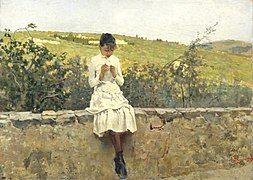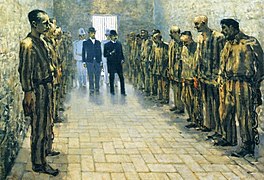Telemaco Signorini

Telemaco Signorini (Italian pronunciation: [teˈlɛːmako siɲɲoˈriːni]; August 18, 1835 – February 10, 1901) was an Italian artist who belonged to the group known as the Macchiaioli.
Biography

He was born in the
In 1855, he began frequenting the
Signorini was a volunteer in the Second Italian War of Independence in 1859, and afterwards painted military scenes which he exhibited in 1860 and 1861. He made his first trip outside Italy in 1861 when he visited Paris, to which he would often return in the decades that followed. There he met Degas and a group of expatriate Italian artists in his orbit, including Giovanni Boldini, Giuseppe De Nittis, and Federico Zandomeneghi; unlike them, however, Signorini remained rooted in Italy.[2] He became not only one of the leading painters of the Macchiaioli, but also their leading polemicist. Art historian Giuliano Matteucci has written: "If we acknowledge Fattori and Lega as the major creative figures of the macchiaioli, then Signorini must surely be recognized as their 'deus ex machina'", describing his role as "that of catalyst and energetic doctrinarian. In transforming attention away from history painting and the academic portrait towards a new poetical interpretation of natural landscape, the part of Signorini was of fundamental consequence to macchiaioli painting."[3]
Exhibitions

His presence at exhibitions was frequent and prolific. In 1860, at the Società Promotrice, he exhibited seven paintings, including I Toscani a Calcinato (The
At the 1882 Società Promotrice, he displayed The Ghetto of Florence and he had three canvases; at 1887 in Venice, six paintings.
Signorini was also a passionate art critic, and was published in art journals, including a series of 99 sonnets titled Le 99 discussioni artistiche di E. G. Moltenì. In 1882, he was nominated professor of the Florentine Academy but declined the appointment.[5]
Works
Among his most notable paintings are The Ward of the Madwomen at S. Bonifazio in Florence (1865,
On the formal level, certainly, the Rob Roy sign arrests our attention and plays with our expectations here as audaciously as a collage element in an early twentieth-century cubist composition. What permitted and encouraged Signorini's experimentation in this remarkably precocious and unprecedented manner was unquestionably the experience of photography ... For with his vision conditioned by that experience, he could accept—as the eye of the camera accepts— what artists before him would normally have pruned or screened out of their interpretations of such a scene.[6]
The influence of photography is often suggested by the asymmetrical compositions of Signorini's works, and his late etchings of street scenes reveal additional influences: those of Japanese art, and Whistler, in their simplifications of shape, atmospheric effects, and flattened treatment of space.
In 1888 he began teaching at the Instituto Superiore di Belle Arti in Florence.[7] He died in that city on February 10, 1901.[8]
Other selected paintings
-
Hills in Settignano
-
La Via del fuoco, 1881
-
Mercato Vecchio in Florence, 1882–83
-
Ghetto of Florence, 1882
-
Bath for Prisoners in Portoferraio, 1890
-
A riposo a Riomaggiore, 1892-94
References
- ^ a b c Steingräber, E., & Matteucci, G. 1984, p. 115
- ^ Broude 1987, pp. 136-137
- ^ Steingräber, E., & Matteucci, G. 1984, p. 36
- ^ Legends of Elba
- ^ ‘‘Dizionario degli Artisti Italiani Viventi: pittori, scultori, e Architetti.’’, by Angelo de Gubernatis. Tipe dei Successori Le Monnier, 1889, page 475-476.
- ^ Broude 1987, pp. 142-143
- ^ Troyer, N. "Signorini, Telemaco". Grove Art Online.
- ^ "Telemaco Signorini", museofattori.livorno.it.
Further reading
- Broude, Norma (1987). The Macchiaioli: Italian Painters of the Nineteenth Century. New Haven and London: Yale University Press. ISBN 0-300-03547-0
- Steingräber, E., & Matteucci, G. (1984). The Macchiaioli: Tuscan Painters of the Sunlight : March 14-April 20, 1984. New York: Stair Sainty Matthiesen in association with Matthiesen, London. OCLC 70337478
- Panconi, T., (1999). Telemaco Signorini, il caso del pittore letterato. In the Antologia dei Macchiaioli, la trasformazione sociale e artistica nella Toscana di metà Ottocento. Pisa: Pacini Editore.
External links
![]() Media related to Telemaco Signorini at Wikimedia Commons
Media related to Telemaco Signorini at Wikimedia Commons






